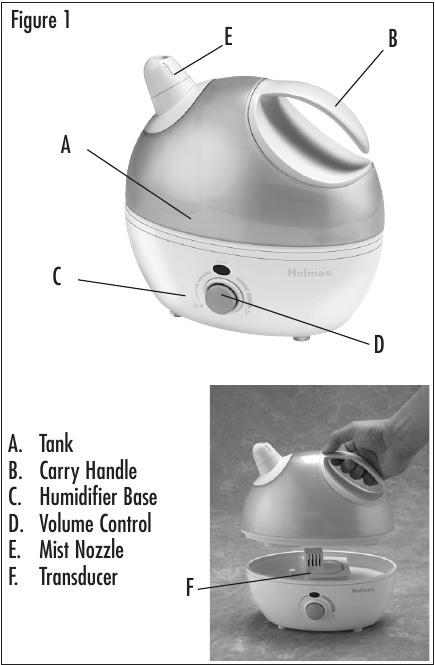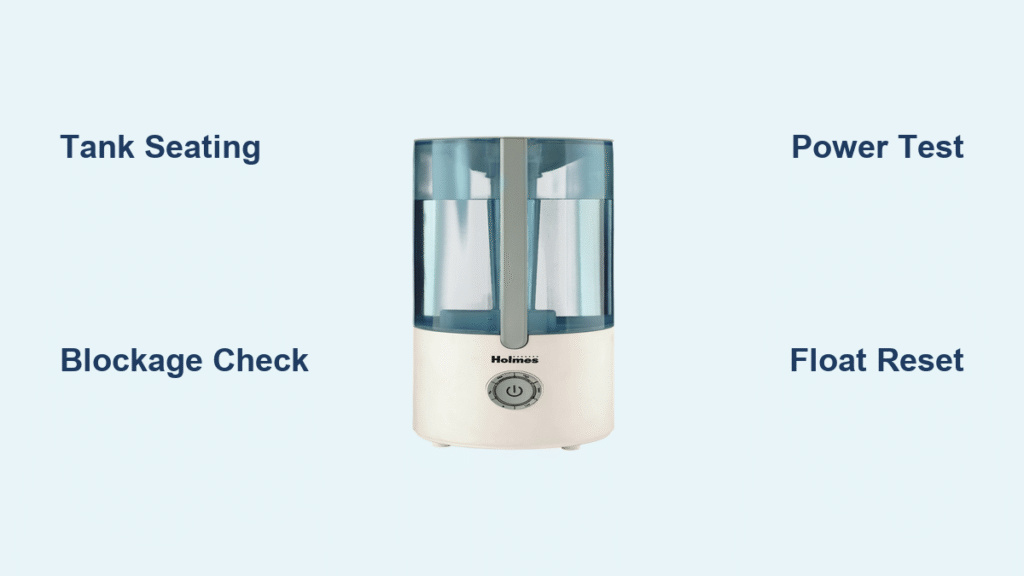Your Holmes humidifier lights up and hums, but zero mist rises into the dry air. You’ve refilled the tank twice, checked the power cord, and still—nothing. This exact scenario frustrates thousands of homeowners every winter when humidity levels plummet. The culprit is almost always a preventable issue within your unit’s water delivery, electrical system, or mechanical components—not a dead appliance.
When your Holmes stops misting, it’s signaling a specific failure point. Most cases stem from four critical areas: water supply blockages, electrical faults, mechanical jams, or factory defects. Ignoring these issues accelerates internal damage through mineral buildup or electrical shorts. The good news? Systematic troubleshooting resolves 85% of “no mist” problems in under 20 minutes with basic household tools. Let’s diagnose exactly why your humidifier fell silent and restore that soothing mist today.
Diagnose Water Supply Failures Before Replacing Parts
Tank Seating and Reservoir Leaks That Kill Mist Output
Improper water flow is the #1 cause of misting failure. Start by removing your water tank completely—don’t just lift it slightly. Reinstall with firm downward pressure until you hear a distinct click. A loose tank creates microscopic gaps preventing water from reaching the base. If it wobbles when gently rocked, realign it. Next, inspect the tank’s bottom for hairline cracks or manufacturing holes (about 1 cm wide). These often hide near seams and drain water before misting begins.
Critical Test: Place colored paper under the base, fill the tank, and watch for leaks within 5 minutes. If water appears, seal temporary holes with electrical tape for immediate testing. For permanent fixes, clean the area with rubbing alcohol, apply thin layers of silicone sealant, and cure for 24 hours. Never operate with visible leaks—this risks electrical damage.
Clearing Hard Water Blockages in 5 Minutes
Mineral deposits from tap water clog inlet tubes and valves, especially in drum-style Holmes units. Remove the water tank and locate the small plastic inlet tube connecting to the base. Hold it against bright light; dark spots indicate calcium buildup. For stubborn clogs:
- Soak the tube in white vinegar for 30 minutes
- Gently scrub with a pipe cleaner (never metal tools)
- Rinse thoroughly under warm running water
- Check the saddle valve (brass clamp on copper pipes) for sediment
- Replace the saddle valve if water flow remains restricted
Pro Tip: If your unit uses a float valve, manually lift the plastic float. It should move freely without sticking. Stuck valves block water entry entirely—clean with vinegar or replace if corroded.
Electrical Failures That Silently Disable Mist Production

Power Verification Beyond Basic Plug Checks
Don’t assume the outlet works—test it with a phone charger first. If the charger operates but your humidifier stays silent, inspect the power cord for frays or kinks. Next, check your circuit breaker; humidifiers often share circuits with space heaters that trip breakers during winter. For Holmes units with external 24-volt transformers:
- Set a multimeter to 24V AC
- Test voltage output while the humidifier attempts to run
- Zero reading means replace the transformer
- Voltage present but no mist? The water inlet valve is likely seized
Warning: Never operate the unit with wet hands or near standing water. Electrical shorts can occur even with minor leaks.
Control Board and Humidistat Failure Symptoms
When lights illuminate but no mechanical action occurs, suspect the control board or humidistat. Unplug the unit, remove the base cover (typically 4-6 screws), and inspect the circuit board near the power connection. Burn marks, swollen capacitors, or white corrosion mean immediate replacement. For the humidistat:
- Set it above current room humidity (e.g., 45% in a 30% room)
- Use a multimeter to test for continuity across terminals
- No continuity? Replace the humidistat—it’s failed
Key Insight: Control boards are model-specific. Match your Holmes unit’s exact number (found on the base sticker) to avoid compatibility issues.
Mechanical Breakdowns Stopping Mist at the Source
Drum and Motor Failures in Evaporative Models
Drum-style Holmes humidifiers rely on rotating water-absorbing pads. If the drum stays frozen while the unit hums, the drive motor or belt has failed. Unplug the unit and attempt manual drum rotation. Stiff resistance means debris is jammed in the shaft—clear it with compressed air. Complete immobility requires belt replacement.
Replacement Steps:
1. Note the belt’s exact routing before removal
2. Match new belt width to the old one (usually 1/4″)
3. Install without over-tightening—it should deflect 1/4″ when pressed
4. Test rotation by hand before powering on
Warning: A humming motor with no drum movement often indicates a burnt-out motor. Replace it if manual rotation feels gritty or locked.
Fan Obstructions Choking Mist Distribution
Even with proper water flow, blocked fans prevent mist dispersion. Remove the water tank and shine a flashlight into the mist outlet. Look for pet hair, dust bunnies, or mineral crusts obstructing the fan blades. Never insert tools—use short bursts of compressed air from multiple angles. For ultrasonic models, check the transducer disc (shiny metal plate in the base) for chalky deposits. Soak it in vinegar for 30 minutes, then gently brush with a soft toothbrush.
Ultrasonic-Specific Fixes for Silent Mist Failure

Transducer Cleaning Without Disassembly
Ultrasonic Holmes units generate mist through high-frequency vibrations. Mineral buildup on the ceramic transducer disc dampens these vibrations. Drain all water, then:
- Locate the transducer (center of the base reservoir)
- Soak a cloth in undiluted white vinegar
- Lay it over the transducer for 30 minutes
- Wipe clean with a soft sponge—no scrubbing!
Critical: Never operate ultrasonic units with hard water. Always use distilled water to prevent rapid re-depositing.
Water Level Sensor Troubleshooting
A stuck float switch tricks your unit into “dry mode.” Remove the tank and find the small plastic float atop the base. Press it down—it should click audibly and spring back freely. If it sticks:
- Soak the mechanism in vinegar for 15 minutes
- Rinse with distilled water
- Dry completely with a lint-free cloth
- Test float movement before reinstalling the tank
Immediate Fixes That Restore Mist in Under 10 Minutes

5-Step Emergency Diagnostic Sequence
When mist vanishes, run this rapid test:
- Tank Check: Remove and reinstall with firm pressure (30 seconds)
- Leak Scan: Place paper under base while filling (2 minutes)
- Blockage Test: Inspect inlet tube against light (1 minute)
- Power Verification: Test outlet with another device (30 seconds)
- Float Test: Manually operate float switch (1 minute)
Pro Tip: If leaks persist after sealing factory holes, check for pinched internal wires compromising the seal—this often causes secondary electrical failures requiring full replacement.
Cost-Effective Component Swaps
Replace these common failure points yourself:
- Saddle valves: $8 part, requires basic plumbing skills (turn off main water first)
- Humidistats: $15, plug-and-play replacement
- Drive belts: $5, takes 10 minutes to install
Warning: If internal electronics show water damage (corrosion, burnt smell), replacement beats repair. Moisture permanently damages circuitry.
Prevent Future “No Mist” Emergencies With Proactive Care
Monthly Maintenance That Doubles Unit Lifespan
Prevent 90% of misting failures with this routine:
- After emptying tank: Wipe base with 50/50 vinegar-water solution
- Every 30 days: Soak inlet tube in vinegar overnight
- Quarterly: Inspect seals for cracks and replace if brittle
- Always: Use distilled water in ultrasonic models
Critical Insight: Hard water users must descale monthly. Mineral buildup permanently damages pumps and valves within 3 months.
When Replacement Beats Repair
Abandon DIY fixes if you see:
– Water pooling around electronics
– Multiple component failures (e.g., motor AND valve)
– Unit older than 5 years with recurring issues
– Repair costs exceeding $50 (new Holmes units start at $70)
Final Tip: Newer Holmes models (2020+) rarely have factory-punched holes—a sign of outdated manufacturing. If your unit fails repeatedly, invest in a current model with improved seals.
Your Holmes humidifier’s silence isn’t permanent—it’s a precise diagnostic signal. By methodically checking water pathways, electrical connections, and mechanical components, you’ll restore mist production in most cases without professional help. Start with tank seating and leak checks; these solve half of all “no mist” emergencies. When mist finally rises, set a monthly maintenance alarm—consistent care prevents 95% of future failures. For persistent issues after trying these steps, replacement is often wiser than chasing multiple failing parts in older units.





